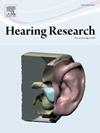在背景噪音下听故事时,年轻人和老年人的眼球运动减少
IF 2.5
2区 医学
Q1 AUDIOLOGY & SPEECH-LANGUAGE PATHOLOGY
引用次数: 0
摘要
听力努力的评估与理解老年人所经历的语言理解困难越来越相关。瞳孔测量法是评估听力努力程度的最常用工具,但也有局限性。最近的研究表明,当努力倾听时,眼球运动减少,并提出了眼球运动指标作为替代措施。然而,大部分的研究是在年轻的成年人中进行的,在并行视觉刺激下,以句子-听力为基础的试验范式。在独立于视觉刺激的情况下,在老年人中,眼球运动在多大程度上反映了连续语音听力的努力程度,目前尚不清楚。在目前的研究中,年轻人和老年人在自由和移动点观看条件下听不同程度背景噪音的连续故事。随着言语掩蔽的增加,眼球运动减少(以注视时间、凝视分散和扫视率为指标)。眼球运动的减少并不取决于年龄组或观看条件,这表明眼球运动可以用来评估不同视觉情况和不同年龄人群的语音掩蔽效果。在实验早期,瞳孔大小只对语音掩蔽敏感。总而言之,目前的研究表明,眼球运动是评估连续语音听力过程中听力努力程度的潜在工具。本文章由计算机程序翻译,如有差异,请以英文原文为准。
Eye movements of younger and older adults decrease during story listening in background noise
Assessments of listening effort are increasingly relevant to understanding the speech-comprehension difficulties experienced by older adults. Pupillometry is the most common tool to assess listening effort but has limitations. Recent research has shown that eye movements decrease when listening is effortful and proposed indicators of eye movements as alternative measures. However, much of the work was conducted in younger adults in trial-based sentence-listening paradigms during concurrent visual stimulation. The extent to which eye movements index listening effort during continuous speech listening, independently of visual stimuli, and in older adults, is unknown. In the current study, younger and older adults listened to continuous stories with varying degrees of background noise under free and moving-dots viewing conditions. Eye movements decreased (as indexed by fixation duration, gaze dispersion, and saccade rate) with increasing speech masking. The reduction in eye movements did not depend on age group or viewing conditions, indicating that eye movements can be used to assess effects of speech masking in different visual situations and in people of different ages. The pupil size was only sensitive to speech masking early in the experiment. In sum, the current study suggests that eye movements are a potential tool to assess listening effort during continuous speech listening.
求助全文
通过发布文献求助,成功后即可免费获取论文全文。
去求助
来源期刊

Hearing Research
医学-耳鼻喉科学
CiteScore
5.30
自引率
14.30%
发文量
163
审稿时长
75 days
期刊介绍:
The aim of the journal is to provide a forum for papers concerned with basic peripheral and central auditory mechanisms. Emphasis is on experimental and clinical studies, but theoretical and methodological papers will also be considered. The journal publishes original research papers, review and mini- review articles, rapid communications, method/protocol and perspective articles.
Papers submitted should deal with auditory anatomy, physiology, psychophysics, imaging, modeling and behavioural studies in animals and humans, as well as hearing aids and cochlear implants. Papers dealing with the vestibular system are also considered for publication. Papers on comparative aspects of hearing and on effects of drugs and environmental contaminants on hearing function will also be considered. Clinical papers will be accepted when they contribute to the understanding of normal and pathological hearing functions.
 求助内容:
求助内容: 应助结果提醒方式:
应助结果提醒方式:


